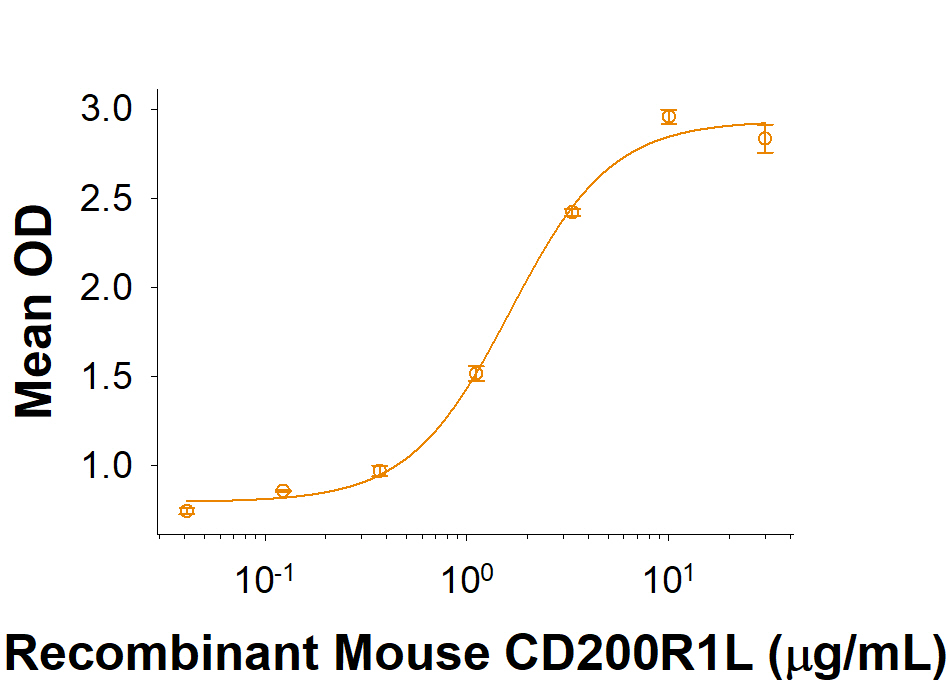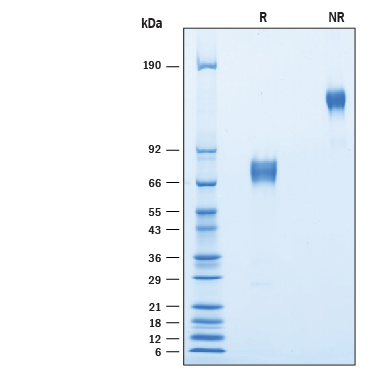Recombinant Mouse CD200R1L Fc Chimera Protein, CF Summary
Product Specifications
| Mouse CD200R1L (Ile25-Thr220) Accession # Q6XJV6.1 | IEGRMDP | Mouse IgG2a (Glu98-Lys330) |
| N-terminus | C-terminus | |
Analysis
Product Datasheets
Carrier Free
CF stands for Carrier Free (CF). We typically add Bovine Serum Albumin (BSA) as a carrier protein to our recombinant proteins. Adding a carrier protein enhances protein stability, increases shelf-life, and allows the recombinant protein to be stored at a more dilute concentration. The carrier free version does not contain BSA.
In general, we advise purchasing the recombinant protein with BSA for use in cell or tissue culture, or as an ELISA standard. In contrast, the carrier free protein is recommended for applications, in which the presence of BSA could interfere.
10198-CD
| Formulation | Supplied as a 0.2 μm filtered solution in PBS with Trehalose. |
| Shipping | The product is shipped with dry ice or equivalent. Upon receipt, store it immediately at the temperature recommended below. |
| Stability & Storage: | Use a manual defrost freezer and avoid repeated freeze-thaw cycles.
|
Scientific Data
 View Larger
View Larger
When Recombinant Mouse CD200 Fc Chimera (Catalog # 3355-CD) is immobilized at 2 µg/mL (100 µL/well), Recombinant Mouse CD200R1L Fc Chimera (Catalog # 10198-CD) binds with an ED50 of 0.35-2.8 µg/mL.
 View Larger
View Larger
2 μg/lane of Recombinant Mouse CD200R1L Fc Chimera was resolved with SDS-PAGE under reducing (R) and non-reducing (NR) conditions and visualized by Coomassie® blue staining, showing bands at 65-85 kDa and 130-170 kDa, respectively.
Reconstitution Calculator
Background: CD200R1L
CD200 Receptor 2 (CD200R2), or CD200R1L, is a type I transmembrane receptor for the CD200 cell surface glycoprotein. Mature CD200R2 consists of an extracellular domain (ECD) containing an Ig-like V-type domain and an Ig-like C2-type domain, a transmembrane segment and a short cytoplasmic domain. The ECD of mouse CD200R2 shares a 76% and 63% amino acid (aa) identity with the rat and human ECD, respectively. CD200R2 is strongly expressed on resting mast cells but deceased upon activation via Fc epsilon R1. It is also observed on monocytes, bone marrow-derived dendritic cells and TH2 cells (1, 2, 4). It has been demonstrated CD200R2 can interact with CD200 (3) and signal through adaptor protein, DAP12, via its lysine residue in the transmembrane region (2). In addition, it has been reported CD200 and CD200R2 interaction alters dendritic cell differentiation and enhances induction of CD4+CD25+Foxp3+ regulatory T cells in mouse transplant model (5).
- Wright, G. et al. (2003) J. Immunol. 171:3034.
- Voehringer, D. (2004) J. Biol. Chem. 279(52):54117.
- Gorczynski, R. et al. (2004) J. Immunol. 172:7744.
- Minas, K. (2006) Crit Rev Immunol 26(3):213.
- Gorczynski, R. et al. (2008) J. Immunol. 180(9):5946.
FAQs
No product specific FAQs exist for this product, however you may
View all Proteins and Enzyme FAQsReviews for Recombinant Mouse CD200R1L Fc Chimera Protein, CF
There are currently no reviews for this product. Be the first to review Recombinant Mouse CD200R1L Fc Chimera Protein, CF and earn rewards!
Have you used Recombinant Mouse CD200R1L Fc Chimera Protein, CF?
Submit a review and receive an Amazon gift card.
$25/€18/£15/$25CAN/¥75 Yuan/¥1250 Yen for a review with an image
$10/€7/£6/$10 CAD/¥70 Yuan/¥1110 Yen for a review without an image
